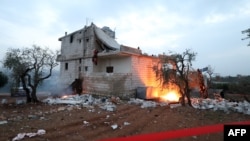Despite lingering doubts about the usefulness of so-called decapitation strikes, U.S. operations to kill senior terrorist leaders are paying dividends, according to one of Washington’s top counterterrorism officials.
Both the Islamic State terror group and al-Qaida have been forced to stay in “survival mode” following the deaths of their leaders as a result of U.S. actions this year, National Counterterrorism Center Director Christine Abizaid said Thursday.
Islamic State, in particular, she said, has been forced to refocus following the death of former emir Abu Ibrahim al-Hashimi al-Qurashi, also known as Hajji Abdallah, following a U.S. special forces raid in northwestern Syria in February.
At the time, senior U.S. military officials described Abu Ibrahim’s death as a “significant blow,” an assessment that has been borne out in the way IS has carried out operations in recent months.
“What’s important about it is it’s not just him,” Abizaid told an intelligence and security conference outside Washington, responding to a question submitted by VOA.
“It's that he is the last in a long line of leaders who are no longer trying to attack the United States and trying to rout Syria and regain territorial control in a way that, I think, has really reflected a major talent loss in ISIS senior leadership,” Abizaid said, using another acronym for the terror group. “[It] has caused them to focus on kind of branch expansion that has diffused the threat and, again, made the focus on the United States less acute than we had seen in prior years.”
The U.S. airstrike that killed longtime al-Qaida leader Ayman al-Zawahiri at the end of July has, likewise, resulted in a cascading effect on the terror organization.
“I think about now how important it was not just for the threat that he posed, but for the tie that he created across the al-Qaida network,” Abizaid said. “That tie is weaker today because he's not on the battlefield.
“And the weaker and the more diffuse that al-Qaida network is, I think, the better for U.S. national security,” she added.
Abizaid’s assessment seems to reflect a shift in U.S. thinking, especially when it comes to Islamic State.
For years, even in the aftermath of the collapse of Islamic State’s self-declared caliphate in Iraq and Syria, U.S. and Western military and counterterrorism officials warned that IS and its key affiliates had structured themselves in such a way that for every key leader who was killed, there was an understudy ready to take his place.
And a recently declassified intelligence assessment written in May 2020 predicted IS was “organizing for a prolonged insurgency while rebuilding many key capabilities that are likely to expand its global reach and the threat it poses to U.S. and Western interests.”
But recent intelligence estimates suggest IS’s hold among its followers in Iraq and Syria may be waning.
While there are still areas that serve as key communication and financial hubs, like the al-Hol displaced persons camp in northeast Syria, the terror group’s fighters have been dispersed across remote areas. And its cadre of fighters, numbering as many as 16,000 last year is now estimated to be fewer than 10,000.
The U.S. and its allies have also pointed to a series of operations following the raid on Abu Ibrahim that have whittled away at IS’s core leadership, including U.S. drone strikes and the arrests of senior IS leaders in Syria and Turkey.
A recent report by the United Nations, based on member state intelligence, went as far as to caution that al-Qaida was poised to surpass IS as the world’s preeminent jihadist terrorist organization, due in part to “a rapid succession of [IS] leadership losses since October 2019, with an as yet unknown impact on its operational health.”
Meanwhile, there are growing questions about the ability of the al-Qaida core to remain relevant and influential with al-Zawahiri gone.
“This is challenging for al-Qaida,” a former Western counterterrorism official told VOA following al-Zawahiri’s death, speaking on the condition of anonymity to discuss recent intelligence assessments.
Those assessments from the U.S., as well as those from several other countries that were shared with the United Nations, caution there are perhaps only a handful of al-Qaida core officials still in Afghanistan, long the group’s base of operations.
Al-Zawahiri’s likely successor, Saif al-Adel, meanwhile, is believed to be in Iran along with the next most senior al-Qaida official, and there are questions as to whether Tehran will let them leave.
Al-Qaida's other top leaders are based in Africa, and intelligence officials say they may be more interested in the fortunes of their particular affiliates than in the broader concerns of the terror group.










